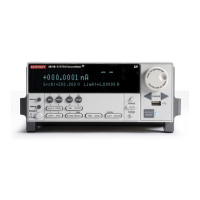14-10 Return to Section Topics 2600S-901-01 Rev. C / January 2008
Section 14: Display Operations Series 2600 System SourceMeter® Instruments Reference Manual
The 16-bit binary equivalent of the returned value is a bitmap. Each bit corresponds to an
annunciator. If the bit is set to “1”, the annunciator is turned on. If the bit is set to “0”, the
annunciator is turned off.
Table 14-2 identifies the bit position for each annunciator. The table also includes the weighted
value of each bit. The returned value is the sum of all the weighted values for the bits that are set.
For example, assume the returned bitmap value is 34061. The binary equivalent of this value is as
follows:
1000010100001101
For the above binary number, the following bits are set to “1”: 16, 11, 9, 4, 3 and 1. Using Table 14-
2, the following annunciators are on: REL, REM, EDIT, AUTO, 4W and EDIT.
Table 14-2
Bit identification for annunciators
Bit
16 15
14 13 12 11 10 9
Annunciator REL REAR SRQ LSTN TALK REM ERR EDIT
Weighted Value*
32768 16384 8192 4096 2048 1024 512 256
Binary Value 0/1 0/1 0/1 0/1 0/1 0/1 0/1 0/1
Bit
8 7
6 5 4 3 2 1
Annunciator SMPL STAR TRIG ARM AUTO 4W MATH FILT
Weighted Value*
128 64 32 16 8 4 2 1
Binary Value 0/1 0/1 0/1 0/1 0/1 0/1 0/1 0/1
* The weighted values are for bits that are set to “1.” Bits set to “0” have no value.
Note that not all of the above annunciators shown in Table 14-2 are used by the Series 2600.
LOCAL lockout
The front panel LOCAL key is used to cancel remote operation and return control to the front
panel. However, the LOCAL key can be locked out to prevent a test from being interrupted. When
locked, the LOCAL key becomes a NO-OP (no operation). Use the following attribute to lock or
unlock the LOCAL key:
display.locallockout = lockout
where lockout is set to one of the following values:
0 or display.UNLOCK
1 or display.LOCK
LOCAL lockout example:
The following command locks out the LOCAL key:
display.locallockout = display.LOCK
Load test menu
The LOAD TEST menu lists script tests (USER and FACTORY) that can be run from the front
panel. Factory script tests (functions) are pre-loaded and saved in non-volatile memory at the
factory. They are available in the FACTORY TESTS submenu.
After a user script is loaded into the Series 2600, it is not automatically added to the front panel
USER TESTS submenu. A menu name and a chunk is added by the user (see
"Adding USER
TESTS menu entries" below).

